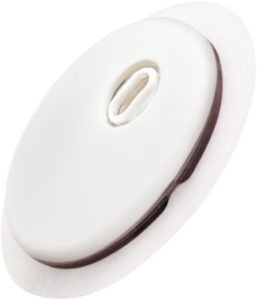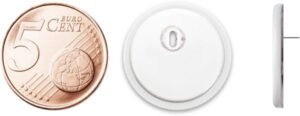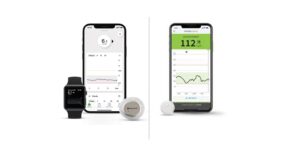The Freestyle Libre 3 is here and it’s next level.
The Freestyle Libre 3 is made by Abbott Laboratories which specialize in medical technology devices and nutritional foodstuff.

The third-generation Freestyle Libre tells us that manufacturer and distribution firms have received enough positive feedback from consumers that it is a device deserving of repetition.
The third-generation format also tells us that it has most likely been advanced and enhanced from its previous generational kinsmen.
CGMs, or Continuous Glucose Monitors, are used to help diabetics manage their blood sugar levels.
For those unaware of what is meant by ‘blood sugar’ levels: When we eat, our food gets broken down into a sugary substance called Glucose. This substance stays within the blood stream until a hormone called Insulin comes to pick it up. The Insulin bubbles attach to the tiny sugary Glucose particles and help them into the cells of our organs, muscles, bones, etc.
If there is no Insulin or the Insulin available is unable to help the sugary Glucose particles into the cells, then the Glucose just stays in the blood stream and causes all kinds of health problems. This is what is refer to as ‘blood sugar.’
As a Type 1 Diabetic, I believe CGMs, like the Freestyle Libre 3, are life-sustaining AND life-saving medical devices. They provide real-time information that not only improves the burdensome and challenging management of blood-sugar levels, but also alerts you to when these blood-sugar levels are in the “danger” zones while you are busy tending to life’s other demands.
Freestyle Libre 3 release dates – are you one of the lucky ones?
Where is the Freestyle Libre 3 available?
- Germany – Initially introduced here and readily available
- The UK – Abbot Technologies has recently announced (March 2022) that FreeStyle Libre 3 is currently available in the UK via the NHS Supply Chain Framework.
- The Netherlands – Limited Availability
- Australia – There is only the Libre 2 available at this moment, but it is hope that people can have the Libre 3 within the next year but historically we’ve seen Australia lag significantly with the speed to market of CGM’s.
What about availability in the US? FreeStyle Libre 3 has been submitted for approval through the FDA with anticipation of endorsement by September 2022. Update!! As of 31st May, Abbott announced FDA clearance. Not currently available on Medicare and Medicaid varies state by state. Expected in pharmacies later this year.
- Rest of the World – we can expect Western Europe and North America to lead the way as is usual for medical devices and pharmaceuticals. Rightly or wrongly capitalism drives health management progress.
**It is important to remember that distributors may be experiencing shipping delays from Abbot Technologies primarily due to the pandemic aftermath.
What’s all the fuss about with the new Libre 3?
The talented innovators at Abbott Laboratories that created the Freestyle Libre 3 were intelligent enough to keep a few of the popular features from the device’s previous versions, and instill them into this generation’s model.

Features including the customizable alarm set-up, 14-day wearability, and of course, the high accuracy blood-sugar readings.
Some new features include:

- The Android version is available at present time, while the iOS version is expected to be accessible in the coming months.
- This is especially useful during sleeping hours or watching a much-anticipated movie in the theater. The last thing you want is to have to interrupt these activities in order to scan your CGM.
- With the 70% size reduction, the FreeStyle Libre 3 is significantly smaller and more compact than previous models; Being approximately the size of 2 stacked pennies makes it much more discreet and less noticeable, especially donning that special outfit for an important event.
- The FreeStyle Libre 3 can be used as an iCGM (Integrated Continuous Glucose Monitor), which means it can be paired as part of an automated insulin delivery (AID) system.
- This option seems to be specific to development in Europe.
Freestyle Libre 3 – the pro’s and con’s and the pricing
- The location of the wearable sensor is a major con in my opinion. Insertion and removal of the sensor is not an easy task when the target area is the posterior surface of the upper-arm. This application site is not easily visible and can pose as a highly tender and sensitive area.
- The price of the device is a bitter-sweet combination – $109 for a one-month’s supply, without insurance
- The Pro: The Freestyle Libre 3 is the same price as previous versions; It’s not often that improvement, enhancement, and progress doesn’t take its toll on our pocketbook. Abbott have done well to make the Libre 3 still lower priced than the Dexcom and Medtronic devices.
- The Con: The Freestyle Libre 3 is the same price as previous versions; $109 is still $109, and may not be affordable for some people.
- On the surface, qualifying for the Freestyle Libre 3 is a wonderful thing. However, the ‘qualifying’ aspects surrounding ALL types of CGMs often leaves me with a bitter taste in my mouth.
CGM use should not require qualifying or justifying parameters. If an individual wants to acquire this device, they should not be obligated to obtain a physician’s note. Some may argue that CGMs are invasive and pierce the skin, therefore they are a medical device and require medical approval. While that may be accurate, to a degree, Glucose meters that require a finger stick (also invasive and pierce the skin), do not require a physician’s note or qualifying parameters in order to purchase; they are available over-the-counter. Here are the Pros and Cons:
- The Pro: Those who qualify, in other words, those who will be deemed medically approved to receive this device, are:
- Women diagnosed with or are at medical risk of developing Gestational Diabetes
- Anyone diagnosed with Type 1 Diabetes
- Individuals with Type 2 Diabetes, ONLY if they are at risk for severe hypoglycemia or have documented “unstable blood sugar.”
- Freestyle Libre 3 is approved for use in the above conditions for those 4 years of age or older.
How does the Libre 3 stack up against its old self and the Dexcom and Medtronic devices?

The original Freestyle Libre, or Libre 1, has all of the following features:
- Automatically measures and continuously stores glucose readings day and night.
- Appropriate for Individuals which are Type 1 Diabetic and/or Insulin Dependent.
- Appropriate for Individuals 18 years of age or older.
- Requires a 60-minute ‘Warm-Up’ time
- ‘Warm-Up’ times are the period of time which the CGM sensor and receiver devices require in order to make a strong connection, prior reporting readings when a new sensor is applied to the body.
- During ‘Warm-Up’ times blood sugar readings are not available; It is recommended to monitor readings with a traditional glucose meter during this time.
- Eliminates the need for routine finger-pricks.
- Routine finger prick test using a blood glucose meter is still highly recommended in order to curb times of rapidly changing glucose levels with Libre 1 because of lack of alarms.
- Sensor is designed to stay on the body for up to 14 days.
- Requires receiver device scan against sensor in order to view real-time reading.
- Efficient one-second scan, even against clothing.
- Receiver device can be either a cellular phone or FreeStyle Libre Reader.
- Sensor is Water-Resistant and designed to be worn while bathing, showering, swimming or exercising
- Sensor is water-resistant in up to 1 meter (3 feet) of water. Do not immerse longer than 30 minutes.
- Compatible with LibreLink App for cellular phones.
- Allows for sharing glucose readings with loved ones, caregivers, and healthcare providers.
- LibreLink can upload to LibreView – A secure, cloud-based diabetes management system that enables you and your healthcare provider toaccess your glucose readings and reports on-demand.
Freestyle Libre 2 has all of the features of Freestyle Libre 1, plus the following:
- Libre 2 can be used for individuals as young as 4 years of age.
- Whereas, Libre 1 is strictly appropriate for individuals 18 years of age or older
- Libre 2 features Customizable High/Low and Signal Loss Alarms
- Libre 2 has alarms that alert you when your sugar is at a specified numerical reading, helping to curb times of rapidly changing glucose levels.
- Alarms make routine finger pricks unnecessary.
- Alarms can also be set if you lose signal between your sensor and receiver device.
Freestyle Libre 3 has all of the features found in the Libre 2 and Libre 1 models. The newer features of the Libre 3 have been stated above
Another very important aspect of a CGM, besides its features, is the level of accuracy in the readings.
How does one determine the ACCURACY of a CGM?
CGMs are evaluated for their accuracy using a mathematical formula known as MARD, Mean value of the Absolute Relative Differences.
To simplify, a CGM system with a MARD <10% is regarded to have good accuracy. Thus, the lower the MARD reading is, the more accurate the device.
The MARD Readings for the Freestyle Libre Models:
Freestyle Libre 1: 11.4% (Libre 1 is only appropriate for age 18 years and older)
FreeStyle Libre 2: 9.2% for adults; 9.7% for pediatrics
Freestyle Libre 3: 9.2% for adults; 9.7% for pediatrics
The Freestyle Libre CGMs are not the only CGMs available on the market. Another popular brand is Dexcom. Currently, the Dexcom G6 model is the most up-to-date and widely available product from Dexcom within its ‘G’ series.
While the Dexcom G7 model has been developed, there is limited availability for this newer model. As of March 2022, the Dexcom G7 has been conservatively released within certain European countries. The G7 will become more widely available throughout Europe over the next few months. G7’s FDA approval request was submitted at the end of 2021 and is likely to be approved by the FDA by summer of 2022, which will make it available for purchase in the U.S.
The MARD Readings for the Dexcom G6 & G7 Models:
Dexcom G6: 9.0%
Dexcom G7: 8.2%
Below are some reference sites regarding MARD measurements, along with accuracy measurements, and gauging effectiveness and safety of FreeStyle Libre devices:
More on MARD: https://www.ncbi.nlm.nih.gov/pmc/articles/PMC7189145/
Accuracy of Freestyle Libre: https://pubmed.ncbi.nlm.nih.gov/31613140/
Effectiveness & Safety of Freestyle Libre: https://pubmed.ncbi.nlm.nih.gov/29553668/
We’re excited to see the arrival of the Libre 3, it’s smaller and has more features and at the same price. This represents a positive development for the diabetes community.

*Disclaimer: All content and information in this blog is for informational and educational purposes only.
This article was written by Adil Maqbool, MD and medically reviewed by Rachael Baker, BNg, CDE, MNgPrac
Last updated on 01/02/24.
Dr. Adil has been a speaker at various medical conferences and health awareness campaigns, where he shared his research and findings, and advocated for accurate medical knowledge. He has been featured in publications such as Cardiology & Vascular Research, The Journal of Physical Fitness and Sports Medicine, and The Lancet.
Rachael Baker is a leading Nurse Practitioner Credentialed Diabetes Educator (CDE) in Brisbane and is passionate about staying up to date with Diabetes Technology and optimising these tools to be implemented in a way that is helpful and practical for people living with Diabetes. Using a holistic approach, Rachael focuses on self-empowerment for individuals living with Diabetes and supports them to live a life without limits.